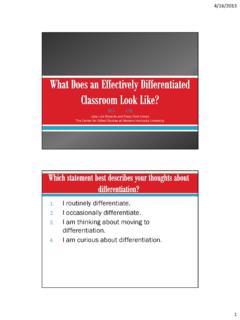Transcription of Overlooked Gems - NAGC
1 Overlooked gems :A National Perspective on Low-Income Promising LearnersA joint publication ofthe National Association for Gifted Childrenand the Center for Gifted Education, College of William and MaryFunding for the conference and publication was provided by the Jack Kent Cooke byJoyce VanTassel-Baskaand Tamra StambaughConference Proceedingsfrom the National Leadership Conferenceon Low-Income Promising LearnersOverlooked gems : A National Perspective on Low-Income Promising LearnersProceedings from the National Leadership Conference on Low-Income Promising LearnersJoyce VanTassel-Baska & Tamra Stambaugh, EditorsA Joint Publication of the National Association for Gifted Children andthe Center for Gifted Education, College of William & MaryOverlooked gems : A National Perspective on Low-Income Promising LearnersConference ProceedingsCopyright 2007 National Association for Gifted ChildrenNational Association for Gifted Children1707 L Street, 550 Washington, DC for Gifted EducationCollege of William & MaryPO Box 8795 Williamsburg, VA 23187-8795 757-221-2362 : Leaving Too Many Children Behind: A Demographer s View on the Neglect of America s Youngest Children, by Harold Hodgkinson (chapter 1), is reprinted with permission of the Institute for Educational Leadership, Washington, DC.
2 Iiii172327313743475359636975778391103119 ContentsPreface Nancy Green, National Association for Gifted ChildrenSection I - Introduction Joyce VanTassel-Baska, College of William and MarySection II The Culture of Poverty in the United StatesHarold Hodgkinson, Center for Demographic Studies Section III Multicultural Perspectives on PovertyAlexinia Y. Baldwin, University of Connecticut Ernesto M. Bernal, Consultant Margie K. Kitano, San Diego State University Section IV What Do We Know About Promising Students of Poverty?Donna Y. Ford, Vanderbilt University Paula Olszewski-Kubilius, Northwestern University Frank C. Worrell, University of California Berkeley Carolyn M. Callahan, University of Virginia Section V Promising Initiatives and ProgramsMary Ruth Coleman, Project U-STARS~PLUS Bruce A. Bracken, Project Athena Robert Gira, Advancement via Individual Achievement (AVID) Tommie Sue Anthony, Advanced Placement (AP) Linda Brody, Center for Talented Youth (CT Y ) Section VI Next Steps Priorities for Action Tamra Stambaugh, College of William and Mary Section VII Participant Reflections Section VIII Annotated BibliographyAuthor and Presenter Bios Overlooked gems : A National Perspective on Low-Income Promising Learners iiiPrefaceWhen a field of researchers and educators brings its decades of expertise and knowledge to bear on a single issue, the outcome can be powerful.
3 Such was the case when the National Association for Gifted Children and the College of William and Mary hosted the National Leadership Conference on Low-Income Promising Learners in April, 2006. The conference brought together the research community as well as the practitioners who work directly with these target student populations in classroom settings. In addition, presenters and responders from outside the field of education brought a rich dimension to the discussion during the time allotted for small group reflection and action planning. NAGC and its members have long focused on underserved populations. Many of NAGC s leaders are pioneers in devising strategies to identify and serve disadvantaged gifted learners, some through resources from the Jacob K. Javits Gifted and Talented Students Education Act, which remains the only federal funding that supports the field of gifted education. With strong leadership from NAGC s president Joyce VanTassel-Baska and the Board of Directors, NAGC s most recent strategic plan broadens the focus on diversity and underrepresented populations to include three key areas.
4 First, NAGC is soundly invested in building alliances with other national organizations that serve low-income learners; models such as AVID and POSSE were also featured at the conference, in addition to the direct partnerships with the Jack Kent Cooke Foundation and William and Mary. Second, NAGC has made a strong commitment to enhancing the competency of teachers who work with underserved populations of public school students. The Mary Frasier Diversity Scholars Program, generously supported by the field s own leaders, was also launched this year to build awareness of gifted children in poverty and to provide Title I teachers with the tools to identify and serve them more effectively. Finally, NAGC has begun a long-term effort to become the clearinghouse for resources a central repository for research and findings on what works for these students, accessible not only to educators, but to classroom teachers and parents as do we go from here? In order for these students needs to be addressed effectively, educators at all levels, as well as parents and the general public, need to better understand the nature of the needs of these students, as well as the multi-pronged educational efforts that can make a difference in their lives.
5 The proceedings from this national forum are one step toward raising awareness and providing practical strategies to help achieve this outcome. In addition, other state and national organizations are planning to replicate the model as well. Many thanks again to Joyce VanTassel-Baska and Tamra Stambaugh from William and Mary, to Jane Clarenbach at NAGC, and to the staff at the Jack Kent Cooke Foundation for investing time and resources in an initiative that can truly make a difference. Nancy GreenExecutive DirectorNational Association for Gifted ChildrenOverlooked gems : A National Perspective on Low-Income Promising LearnersSection III - Multicultural Perspectives on Poverty IntroductionJoyce VanTassel-BaskaCollege of William and MaryPresident, National Association of Gifted ChildrenMany things can wait. Children cannot. Today their bones are being formed, their blood is being made, their senses are being developed. To them we cannot say tomorrow.
6 Their name is today. Gabriela Mistral (Chilean teacher 1899 - 1957)A recent report from The Education Trust (2005) posits that states are shortchanging their low-income and minority students by spending less money per student in high poverty schools, and less money in general for schools with higher percentages of minority students. Based on funding reports from 2003, the United States spent $907 less per school district of poverty and $614 less in school districts with high percentages of minority students when compared to districts with high percentages of wealthier or Caucasian students. Moreover, teachers in high poverty and high minority schools were found to be less experienced, were more often teaching out of their field of expertise, and received less money for the job of teaching. Other national reports suggest that the achievement gaps between students of poverty and students of non-poverty continue to exist, especially in reading and mathematics (NCES, 2005).
7 Calls to action include equity in state funding mechanisms, greater state and national awareness of the issues of poverty, a need for highly qualified teachers in high poverty schools, targeted professional development for pre-service teachers, and a stronger research agenda specific to students of poverty and their achievement attainment. Yet there is no aspect of these reports that focus on the loss of talent among top students in these groups, an area of grave concern to many gifted educators. Monograph PurposeThis monograph brings together the work of national stakeholders in gifted education and beyond gifted education on the critical issue of child poverty among students who show academic and intellectual promise for positive contributions in various areas of study. It has been compiled in order to provide the field of gifted education with a blueprint for working in schools with children of poverty, for activating community-based opportunities for them, and for forging new partnerships and collaboratives with universities and other agencies to deliver relevant monograph is organized into eight sections that outline the major presentations from the April 24-25, 2006, national conference hosted by the National Association of Gifted Children and the College of William and Mary and sponsored by the Jack Kent Cooke Foundation.
8 Held at the Carnegie Endowment for Peace, in Washington, DC, the conference purposes were threefold: To understand the current state of the art from research and practice in working effectively with children and youth living in poverty,To create bridges between the gifted community and the general education community on collective successful strategies for provision of talent development services, andTo create a policy and research agenda that addresses the key targets for action in leadership arenas on these by 80 educators representing 30 states, the conference provided opportunities for participants to hear perspectives on poverty from national, state, and local educator experts charged with the responsibility of providing assistance to such learners. Moreover, the group heard from the foundation world as well, on how program funding has been used to reach this population of interest.
9 After multiple presentations, participants formed cross-disciplinary groups to discuss key issues relevant to crafting an action agenda for the field. The synthesis of these ideas framed by the groups is found in the concluding chapter of the monograph, which highlights the recommendations made regarding the important issues of identification, interventions, transition, and retention as well as other priority are many issues that need to be understood and accounted for in developing and implementing programs and services for promising students of poverty. These issues involve their psychological, physiological, cultural, and educational facets of functioning. From a psychological perspective, these students must be viewed as individuals, as we are well aware of studies suggesting their view of fate control, their sense of self-esteem and efficacy, their attributions for success and failure, their resilience, and their educational aspirations may often be compromised by their circumstances.
10 From a physiological perspective, these students must be considered at risk for appropriate health care at key stages of development and may continue unhealthy intergenerational patterns of early pregnancy, drug abuse including smoking and alcohol, and mental health problems. 2 Overlooked gems : A National Perspective on Low-Income Promising LearnersFrom a cultural perspective, these students often represent distinctive minority cultures, with specific orientations and attitudes toward school and learning, often favoring their chances for success. Yet lack of advanced parental education, coupled with lack of financial resources, can conspire to limit the aspirations of such students at critical ages. Cultural values that emphasize group cohesion and family obligations over individual achievement in school and beyond inadvertently set up tensions for these students in making educational choices, in committing time and effort to educational agendas, and to planning their futures in deliberate an educational perspective, these students may often be trapped in schools that do not acknowledge the presence of gifted children, that do not offer appropriate level intellectual stimulation, and that do not provide the value-added services necessary to encourage talent development.















